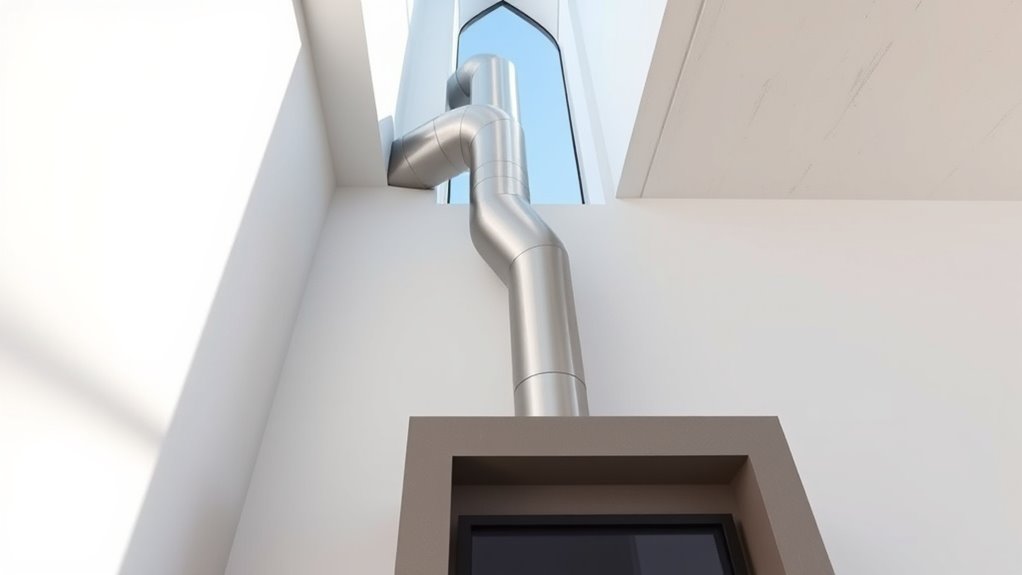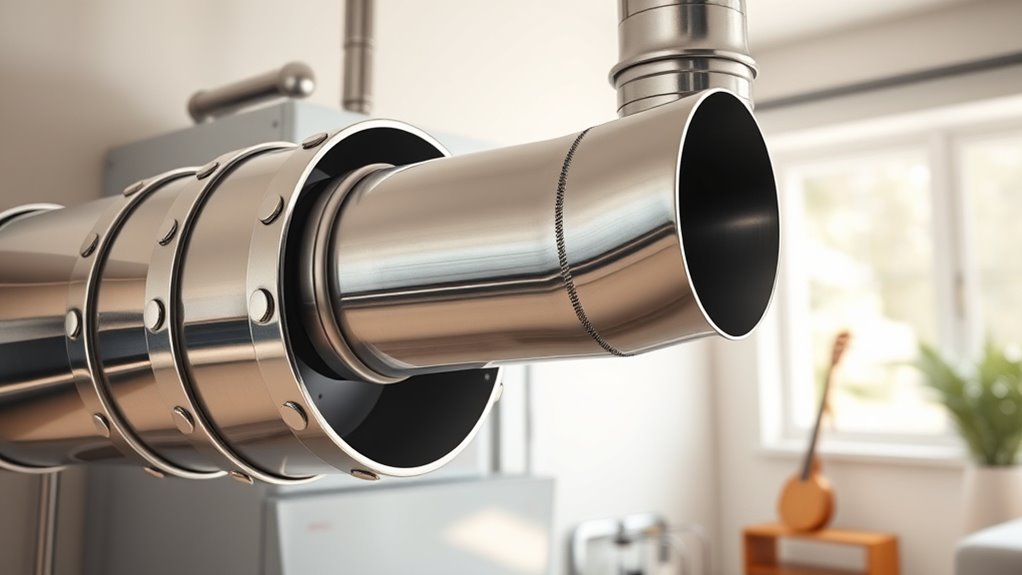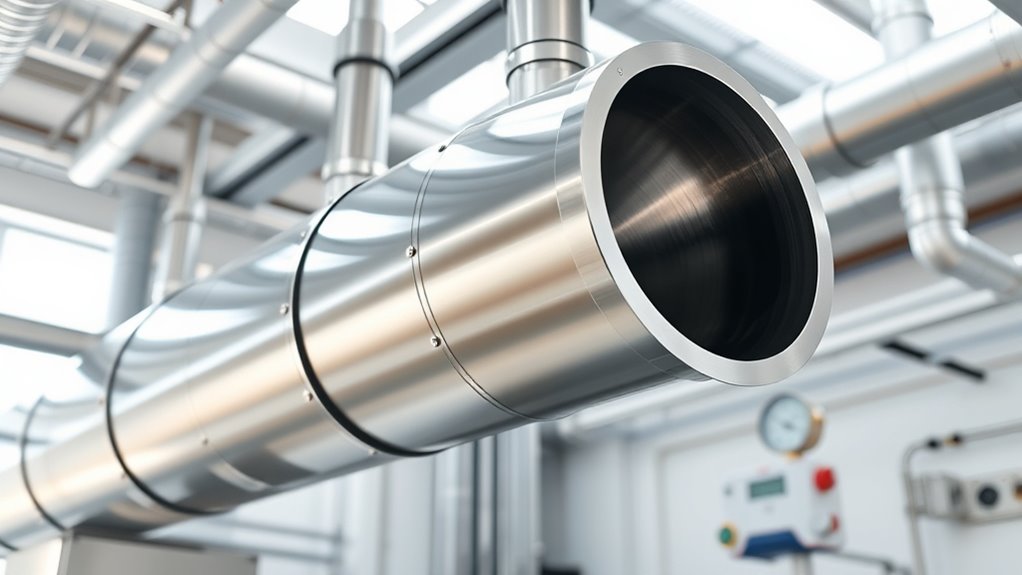A flue pipe is an essential component used to vent exhaust gases from heating appliances outside, ensuring safe indoor air quality. It prevents the accumulation of toxic gases and improves energy efficiency by managing airflow effectively. Flue pipes are commonly utilized in both residential and commercial heating systems and are available in various types and materials to meet specific requirements. Understanding flue pipes is crucial for anyone looking to maintain a safe and efficient ventilation system.
Definition of a Flue Pipe

A flue pipe is essential for safely venting exhaust gases from appliances like furnaces, water heaters, and stoves. It directs harmful byproducts, such as carbon monoxide, outdoors, ensuring safety and efficiency in your home.
Made from heat- and corrosion-resistant materials, flue pipes prevent toxic gas buildup indoors. Their design varies based on the appliance, but their main purpose is to maintain air quality and protect occupants by ensuring proper ventilation.
Components of a Flue Pipe
Understanding the components of a flue pipe is crucial for ensuring effective ventilation systems. A typical flue pipe includes key elements such as the outer casing, which provides structural support and insulation, and the inner liner, built to handle high temperatures and corrosive gases.
Seals and joints are essential for maintaining airtight connections, preventing leaks that can hinder ventilation efficiency. Additionally, dampers regulate airflow, while rain caps protect against precipitation and debris.
Familiarizing yourself with these components is essential for selecting and maintaining an efficient flue system, ensuring safe venting of exhaust gases from combustion appliances.
How Flue Pipes Work
Flue pipes are essential for safely venting exhaust gases from combustion appliances outside a building. They channel harmful byproducts like carbon monoxide and soot away from indoor spaces, reducing air contamination risks.
The process starts when fuel is burned, producing hot gases that rise through the flue pipe due to convection. A well-designed flue pipe ensures proper draft to efficiently vent gases and prevent backdrafts.
Additionally, insulation is vital to minimize heat loss and prevent condensation, which can cause corrosion. Properly functioning flue pipes are crucial for safe and efficient ventilation.
Types of Flue Pipes
When it comes to flue pipes for ventilation, it’s crucial to choose the right material based on your specific application.
The main types include stainless steel, aluminum, and PVC, each offering different levels of durability and performance.
Consider factors such as the intended use, temperature tolerance, and installation requirements to ensure optimal functioning.
Selecting the right flue pipe can enhance safety and efficiency in your ventilation system.
Material Variations Explained
When selecting flue pipes, understanding the materials available is crucial for meeting your specific needs. Here’s a quick overview of the most common materials:
| Material | Advantages | Disadvantages |
|---|---|---|
| Stainless Steel | Highly durable, corrosion-resistant | Higher cost, needs insulation |
| Clay | Excellent heat resistance | Brittle and heavier |
| PVC | Lightweight and easy to install | Limited temperature tolerance |
Stainless Steel: Ideal for high-temperature applications due to its longevity and resistance to corrosion.
Clay: Commonly used in traditional setups for its strong thermal insulation properties, though it is heavier and can be brittle.
PVC: Best suited for low-temperature systems; however, it may not endure extreme conditions.
Choosing the right material is essential for ensuring effective ventilation tailored to your specific requirements.
Common Applications Noted
Different types of flue pipes cater to specific ventilation needs. Here’s a quick overview to help you choose the right one for your application:
- Single-Wall Flue Pipes: Ideal for residential use with wood stoves, these pipes are cost-effective and straightforward for venting gases.
- Double-Wall Flue Pipes: Best for high-efficiency furnaces and boilers, they offer insulation that enhances safety and performance.
- Stainless Steel Flue Pipes: Perfect for corrosive environments like industrial settings, these pipes provide exceptional durability.
- Flexible Flue Pipes: Designed for tight spaces, they allow for easier installation where rigid pipes may not fit.
Selecting the appropriate flue pipe is crucial for ensuring proper airflow and the efficient operation of your heating system.
Installation Considerations Highlighted
When selecting a flue pipe, it’s essential to consider several key factors that directly affect both performance and safety. Here’s what you need to know:
- Material: Choose between stainless steel and aluminum. Stainless steel is typically more durable and resistant to corrosion, making it a better long-term investment.
- Diameter: Ensure the flue pipe’s diameter aligns with your appliance’s specifications. This is crucial for maintaining proper airflow and preventing backdrafts.
- Installation Angle: The angle at which the flue pipe is installed is vital for effective exhaust flow. Incorrect angles can lead to blockages and reduce efficiency.
Materials Used in Flue Pipe Construction
Flue pipes are made from several materials, each chosen for its specific benefits. The most common materials include:
- Stainless Steel: Highly resistant to corrosion and high temperatures, making it suitable for gas and oil applications.
- Aluminum: Lightweight and rust-resistant, ideal for residential heating systems.
- Galvanized Steel: Coated to prevent rust, effective in less demanding environments.
- Refractory Materials: Used for high-temperature needs, often in industrial settings.
Choosing the right material is crucial for ensuring the efficiency and safety of your ventilation system, as it helps effectively channel exhaust gases while maintaining structural integrity.
Purpose of a Flue Pipe in Ventilation
The primary purpose of a flue pipe in ventilation is to effectively remove exhaust gases from enclosed spaces, ensuring that harmful emissions are directed outside.
This process is crucial for improving indoor air quality and maintaining a safe environment.
A well-designed flue pipe system is essential for promoting a healthy living or working space.
Exhaust Gas Removal
Effective exhaust gas removal is crucial for ensuring safety and air quality in ventilation systems. Flue pipes are essential for directing harmful gases away from living spaces, minimizing health risks.
Here’s how flue pipes contribute to effective exhaust gas removal:
- Containment: They safely transport toxic gases, like carbon monoxide, outside the building, protecting occupants from exposure.
- Pressure Maintenance: Flue pipes regulate pressure in the ventilation system, ensuring optimal performance.
- Temperature Control: They dissipate heat from combustion, reducing fire hazards.
For a safe and efficient ventilation system, proper installation and maintenance of flue pipes are vital.
Air Quality Improvement
Ventilation systems significantly enhance indoor air quality, with flue pipes being a key component.
These pipes expel harmful gases and pollutants from combustion processes, ensuring safe and breathable indoor environments. By effectively removing exhaust, flue pipes prevent the buildup of carbon monoxide and other harmful substances, reducing health risks.
They also allow for the influx of fresh air, which is essential for maintaining optimal oxygen levels.
For both residential and commercial spaces, proper installation and maintenance of flue pipes are crucial for maximizing their effectiveness and meeting safety standards.
Importance of Proper Flue Pipe Installation
Proper flue pipe installation is crucial for ensuring safe and efficient operation of heating systems. Here’s why it matters:
- Prevents Backdrafts: A correctly installed flue pipe effectively vents combustion gases outside, minimizing the risk of dangerous gas accumulation indoors.
- Controls Condensation: Proper installation helps reduce condensation, protecting the flue from corrosion and extending its lifespan.
- Ensures Compliance: Following installation standards ensures adherence to local building codes and safety regulations, safeguarding users and property.
Neglecting proper installation can lead to serious safety risks and costly repairs.
Prioritize proper flue pipe installation to maintain a safe and efficient heating system.
Common Applications of Flue Pipes
Flue pipes are essential in both residential and industrial applications.
In homes, they safely vent combustion gases from heating systems, ensuring a comfortable and secure environment.
In industrial settings, flue pipes play a vital role in removing exhaust and pollutants, helping to maintain air quality and adhere to environmental standards.
Understanding these functions can help you make informed decisions about heating and ventilation solutions for your space.
Residential Heating Systems
Residential heating systems utilize flue pipes to safely expel combustion gases, ensuring indoor air quality and resident safety. Here’s how they function across different heating methods:
- Furnaces: Flue pipes direct exhaust from gas or oil-fired units outside.
- Boilers: They vent steam and hot water systems that burn fossil fuels.
- Fireplaces: Flue pipes allow smoke and gases to escape, enhancing both safety and aesthetics.
Proper installation and maintenance of flue pipes are crucial to prevent backdrafts and the build-up of harmful gases like carbon monoxide.
Regular checks can improve system efficiency and safety, ensuring a comfortable home environment.
Industrial Ventilation Solutions
Flue pipes are essential in industrial ventilation, effectively removing harmful emissions from manufacturing, power generation, and chemical processes. They transport combustion gases and pollutants away from workspaces, ensuring employee safety and compliance with environmental regulations.
Common uses include industrial boilers, furnaces, and incinerators, where proper venting is vital for efficiency. Additionally, flue pipes help manage temperature and improve air quality by preventing toxic substance buildup.
Industries like pharmaceuticals and food processing rely on flue pipes to maintain hygiene and safety standards, showcasing their versatility across sectors.
For specific applications or regulations in your industry, consult with a ventilation expert to ensure optimal solutions.
Flue Pipes in Residential Heating Systems

Flue pipes are essential for safe and efficient residential heating systems. They direct harmful combustion gases away from your home, preventing dangerous situations like carbon monoxide buildup.
Here’s why flue pipes are vital:
- Safe Ventilation: They expel combustion gases safely outside.
- Optimal Draft Control: They ensure proper airflow for effective fuel combustion and heating.
- Corrosion Prevention: They minimize moisture accumulation that can cause system damage.
Regular installation and maintenance of flue pipes are crucial for a safe heating environment in your home.
Flue Pipes in Commercial Ventilation
Flue pipes are essential for safety in commercial ventilation systems. They safely channel exhaust gases, preventing hazardous emissions in various industries like food processing and manufacturing.
Properly functioning flue pipes are crucial for operational efficiency and regulatory compliance, directly impacting safety standards and system performance. Understanding their role helps ensure safe and compliant ventilation practices.
Importance in Safety
The Importance of Flue Pipes in Commercial Ventilation Systems
Flue pipes are essential components of commercial ventilation systems, ensuring safety by effectively managing hazardous gases and fumes. Here’s why they matter:
- Preventing Toxic Exposure: Flue pipes are crucial for removing harmful emissions, protecting the health of personnel by minimizing inhalation risks.
- Reducing Fire Hazards: Properly installed flue pipes safely direct flammable gases outside, significantly lowering the risk of fire incidents.
- Enhancing System Efficiency: Well-functioning flue pipes improve ventilation system performance, ensuring optimal air quality and reducing the chances of system failures.
Understanding these key functions helps maintain a safe and efficient environment in commercial settings.
Applications in Industries
Flue pipes are crucial across various industries for ensuring air quality and safety. They are essential in manufacturing, food processing, and energy production, as they effectively remove exhaust gases and pollutants from industrial processes.
In food processing, flue pipes prevent harmful fumes from contaminating products. In energy production, they manage emissions from combustion, while in chemical manufacturing, they safely vent hazardous vapors to protect worker health and the environment.
Utilizing flue pipes in ventilation systems not only enhances operational efficiency but also ensures compliance with safety regulations. For businesses looking to improve air quality and safety standards, investing in reliable flue pipe systems is key.
Maintenance of Flue Pipes
Proper maintenance of flue pipes is essential for optimal performance and durability.
To ensure they operate effectively, follow these key maintenance steps:
- Routine Inspections: Regularly check for corrosion, cracks, or leaks that can affect functionality.
- Cleaning: Clear out soot and debris at least once a year to maintain proper airflow.
- Professional Servicing: Hire qualified technicians for comprehensive checks and repairs, especially for intricate systems.
Safety Considerations for Flue Pipes

Safety Considerations for Flue Pipes
Flue pipes are essential for venting gases safely, but neglecting safety considerations can lead to serious hazards. To ensure safe operation, focus on these key areas:
- Proper Installation: Ensure that flue pipes are installed according to building codes to prevent issues.
- Regular Inspections: Schedule inspections to identify and address potential problems early.
- Avoid Blockages: Clear any obstructions to prevent carbon monoxide buildup, which can be deadly.
- Check for Corrosion: Inspect pipes for corrosion that could lead to dangerous gas leaks.
- Ensure Proper Insulation: Adequate insulation minimizes fire risks.
- Maintain the System: Regular maintenance prevents system failure and inefficiency.
Troubleshooting Flue Pipe Issues
How can you identify issues with flue pipes effectively? Early recognition of problems is crucial for safety. Look out for these common signs:
- Unusual Noises: Listen for any strange sounds coming from the flue.
- Smoke Backflow: Check if smoke is entering your living space instead of venting outside.
- Increased Carbon Monoxide Levels: Use a detector to monitor carbon monoxide levels in your home.
To troubleshoot:
- Visual Inspection: Look for cracks, blockages, or corrosion on the flue pipe.
- Smoke Test: Perform a smoke test to ensure proper venting without leaks.
- Professional Help: If you notice any issues, consult a qualified technician for a detailed inspection.
Promptly addressing flue pipe issues ensures safe operation and reduces ventilation risks.
Regular maintenance can also prevent problems from escalating.
Regulatory Standards for Flue Pipes
Regulatory standards for flue pipes are crucial for ensuring safe ventilation systems. These standards cover materials, design, and installation to prevent hazards like carbon monoxide buildup and fire risks.
Key organizations, such as the International Organization for Standardization (ISO) and the American National Standards Institute (ANSI), set performance criteria and safety measures. Additionally, compliance with local building codes is vital, as they address specific environmental and structural conditions.
Regular inspections and maintenance are also important to ensure flue pipes meet safety standards. Following these regulations helps maintain the integrity of ventilation systems in both residential and commercial settings.
Innovations in Flue Pipe Design
Innovations in flue pipe design are revolutionizing ventilation systems by enhancing efficiency and safety. Here are the key advancements you should know:
- Insulated Flue Pipes: These pipes effectively reduce heat loss, enhancing energy efficiency and minimizing condensation issues.
- Modular Systems: They offer flexible design options for easier installation and customization to fit various building structures and ventilation requirements.
- Smart Technology Integration: Advanced sensors and automation systems improve monitoring, ensuring optimal performance and timely maintenance alerts.
These innovations not only boost ventilation system functionality but also support sustainable building practices, aligning with the growing focus on environmental responsibility in engineering.
Conclusion
A flue pipe is a crucial component of ventilation systems, designed to safely channel harmful gases away from living spaces. Its durable construction ensures efficient airflow, protecting indoor air quality and overall health. Proper installation and maintenance are essential to prevent potential issues. As technology advances, flue pipes continue to evolve, enhancing their effectiveness in ventilation systems. Understanding their purpose and functionality can help you make informed decisions regarding ventilation in your home or business.

I’m Allen Kim, the chief editor of plumbinginto. I am a mid level plumber and assign to an local firm over 4 years of experience. During the working period, most of my experience is related to the house plumbing. I learned about the thing, when working with most experienced people in this sector, one must be as good as the inspector or better with knowledge of the project as well as the practical aspects of plumbing industry.